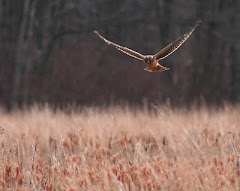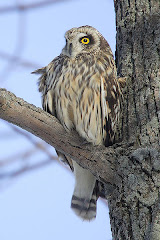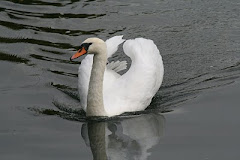
During December 2010 it was difficult to believe that any bird could survive such a prolonged spell of extremely cold weather. The temperature in our garden dropped to well below -10oC on several occasions and was consistently below freezing throughout the day and night for much of the month. The sight of a pair of wrens, one of our smallest birds, apparently looking for somewhere warm to roost one evening was quite moving. They flitted about under the garden furniture for several minutes but nowhere was suitable. I once read that 61 wrens had been counted coming out of the same nest box after a particularly cold night – it reminded me of the ‘how many people can you cram into a mini’ challenge. I wondered if they were coming out and going back in again through a rear entrance.
The smallest birds obviously face the biggest challenge but there are serious threats to birds of all sizes. I watched from the bedroom window as a heron fished very successfully at the edge of the river, amazed by the speed at which it turned and lunged when it had a fish in its sights. The movement of the water had prevented it freezing over and the heron seemed to have no difficulty in finding prey of a suitable size. I concluded, wrongly as it turned out, that the local heron population would see out the cold spell with little problem as long as the river didn’t freeze over.
The next day I observed from the bedroom window what I thought was a strange aspect of heron behaviour and searched the internet in vain for an explanation. One individual was standing in the water, patiently awaiting its next meal, whilst another was lying face down on the river bank a few metres away, its wings spread out on the snow-covered grass. I left for just a few seconds to tell my wife to come and see the dead heron and when I looked out of the window again the ‘dead’ bird had gone. I could find no description of herons playing dead but the odd behaviour remained a mystery for only a few more hours. The sight that met me as I crossed the bridge the following morning made it all too clear why the heron had been behaving in such a bizarre way. There it was, lying dead in the water with its neck twisted in a grotesque pose – it hadn’t been ‘playing dead’, it had been dying.
It was by no means the only casualty in and around our garden. A few days later, only a few metres from the last resting place of the heron, a dead mallard was seen floating on its back. This was the second mallard victim of the winter near the house. The first had been floating upright, the only indication that all was not well being the fact that its head was under the surface of the water.
Such was the severity and length of the cold weather that I was seriously concerned about the chances of survival of our resident barn owls. I read recently that barn owls originally evolved in a warmer and drier climate than we have in the UK and that mortality peaks from December to March. They have a higher metabolic rate than most other owls and their feathers do not have good insulating properties. During very extreme winters (such as 1946/7 and 1962/3) it is thought that more than half the population of Britain may be wiped out. Given all of this I thought the chances of survival were slim and I resorted to tossing the odd dead mouse, caught in traps in the workshop, into the roof space near the nest box.One of my Christmas presents had been a nest box camera with infra red illumination. I had decided to place it in the roof space pointing towards the owl box entrance rather than inside one of our many small nest boxes usually occupied by tits, robins and tree sparrows. This I did towards the end of February and for the next couple of weeks I had several glimpses on the old TV set in the stable of one of our owls. I knew for sure now that one of the pair had survived but I was becoming increasingly concerned that for the second time in two years we had lost the other one. Then, during one of my frequent visits to the stable, I witnessed something I had only ever read about. Not only had both owls survived but there they were, sitting on a roof beam in front of the camera, engaged in what the Barn Owl Trust describes as ‘mutual preening and cheek rubbing’. Spring had well and truly arrived.



















.jpg)
























No comments:
Post a Comment